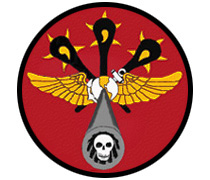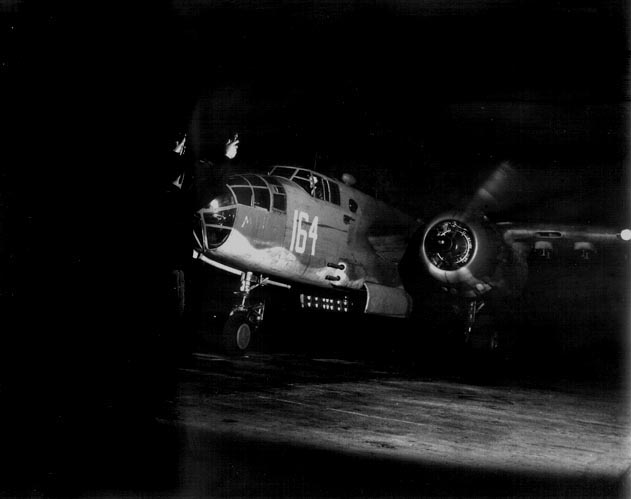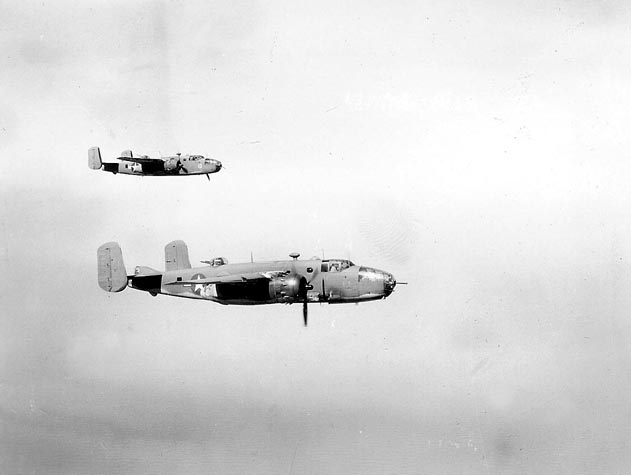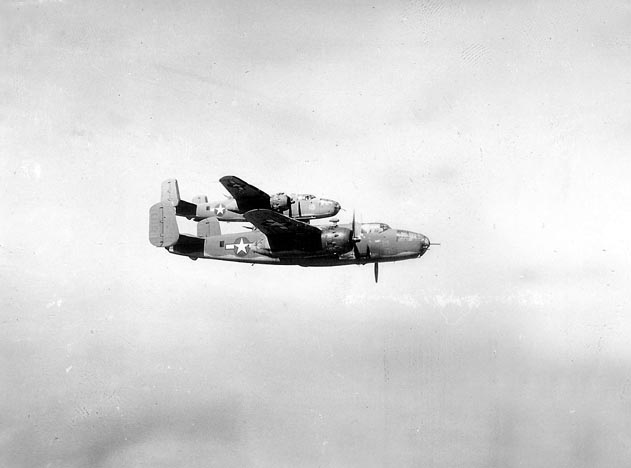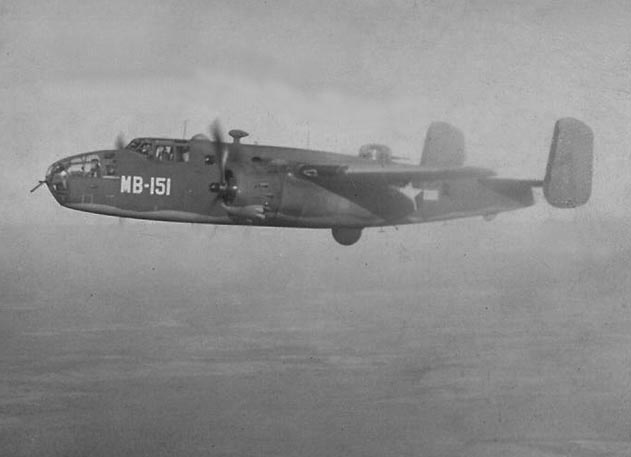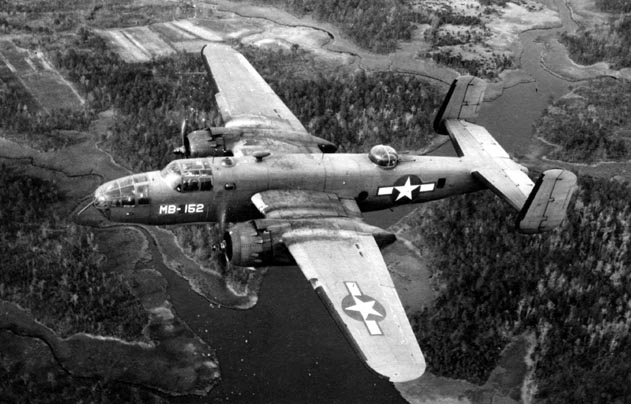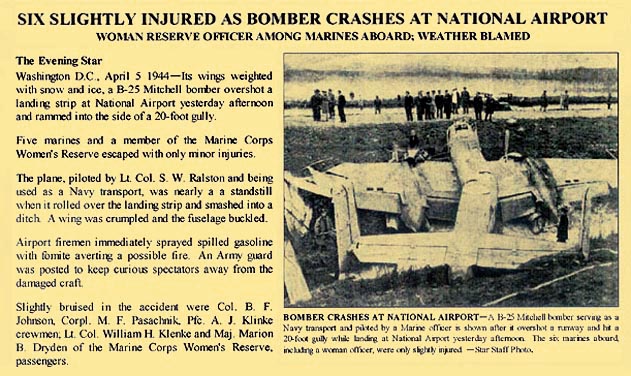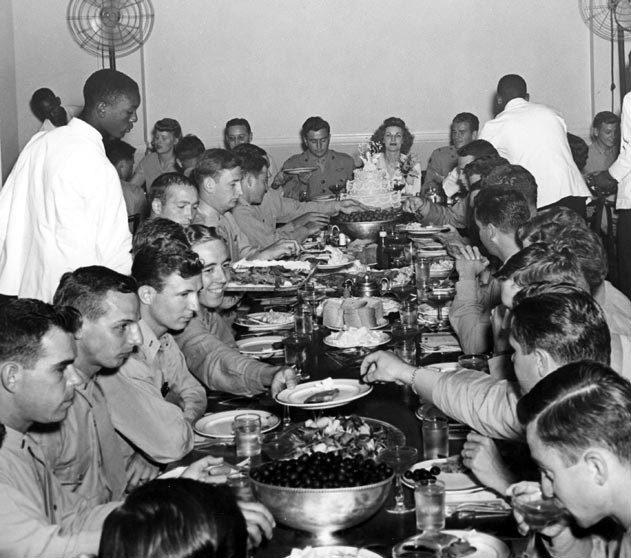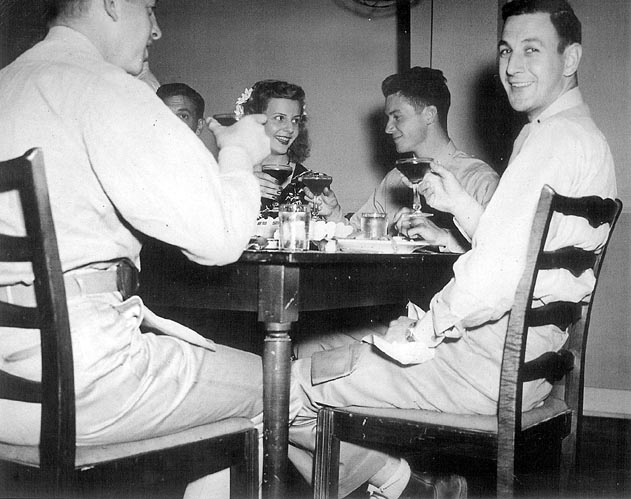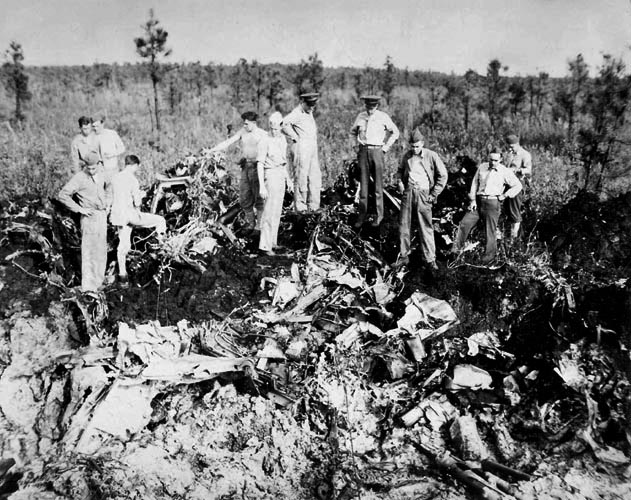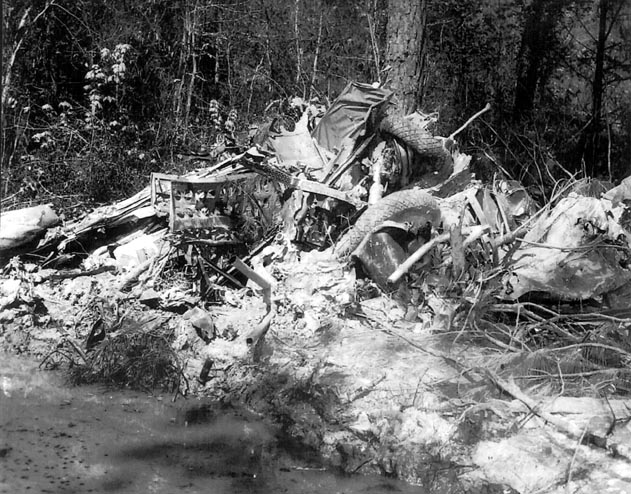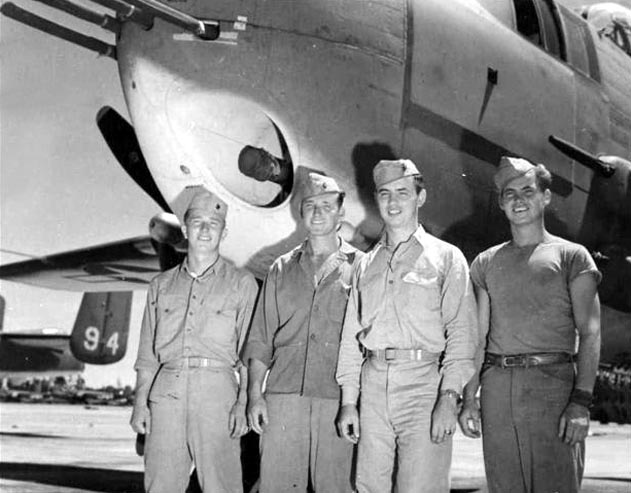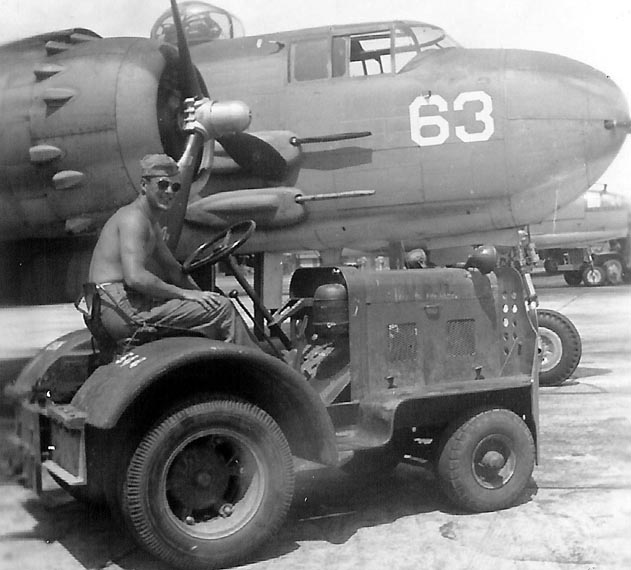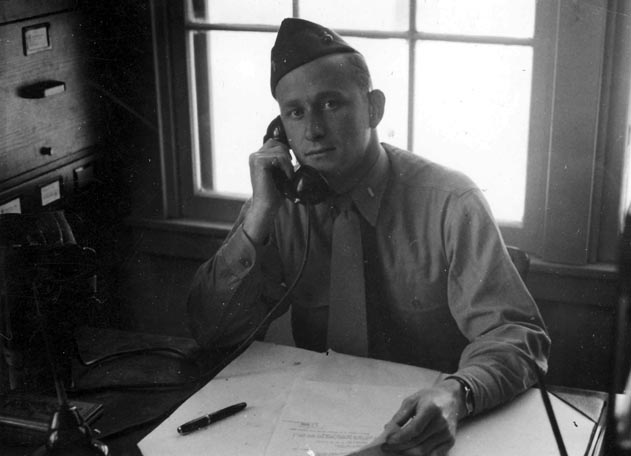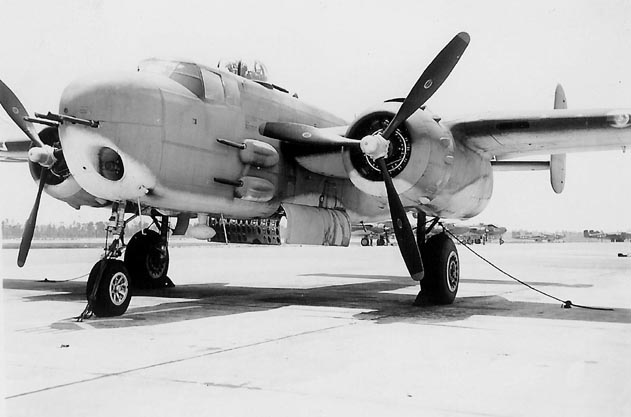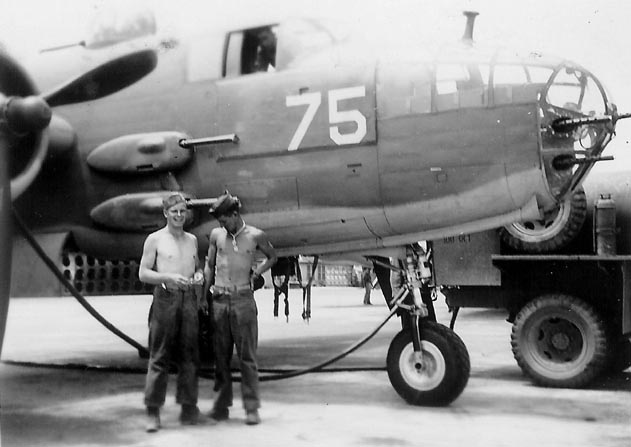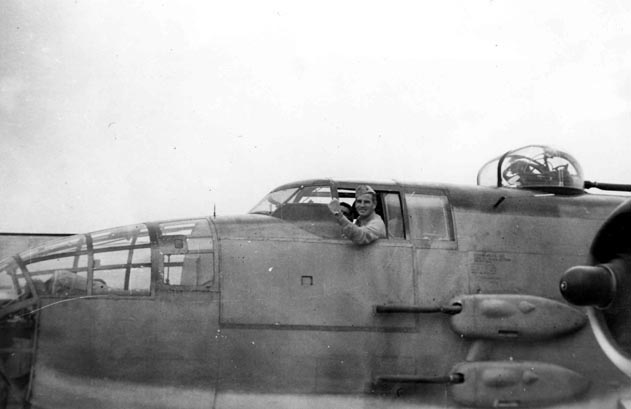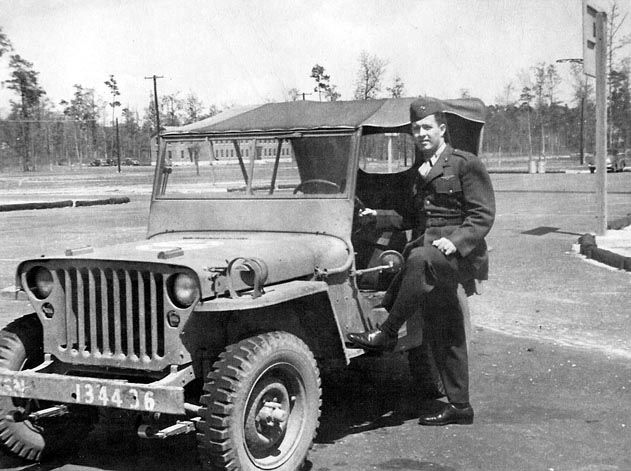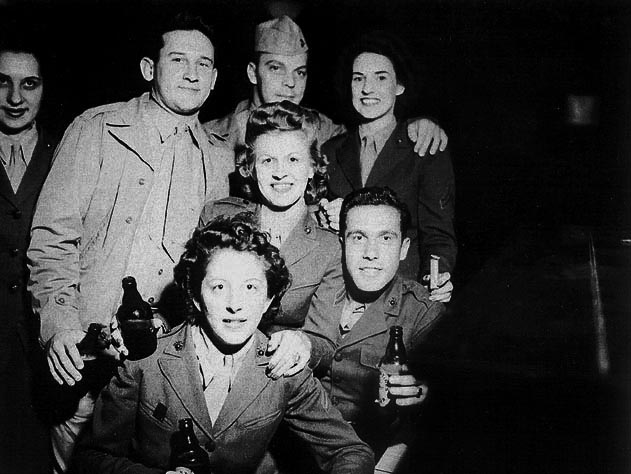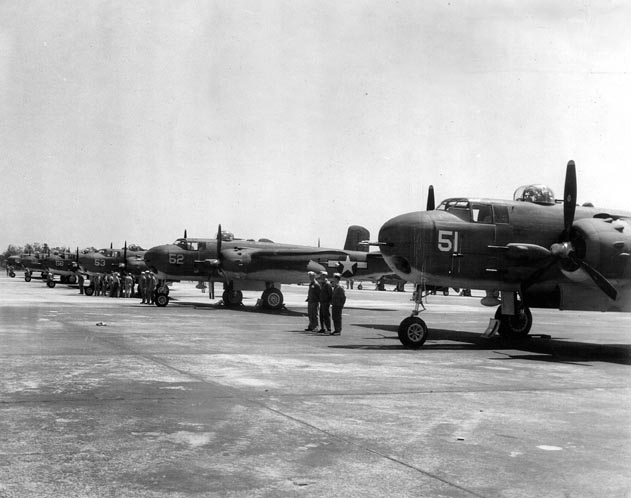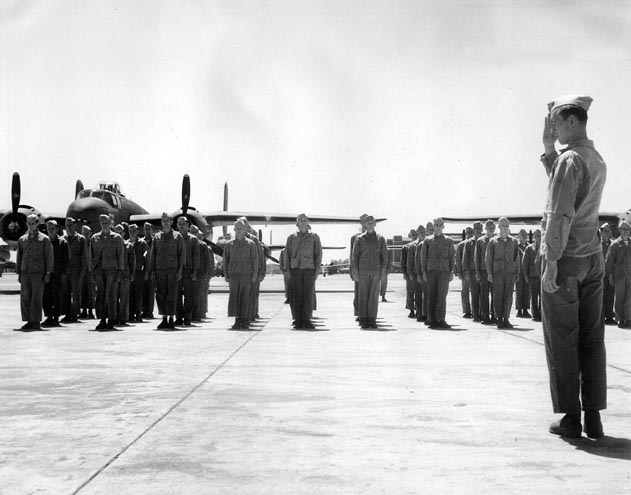|
|
||
|
|
||
|
|
RETURN TO MCAS CHERRY POINT: PAGE 1 On March 22, 1944 with their training completed, VMB-613 had returned to MCAS Cherry Point, resettled into their area and continued training hops. Just as it looked that VMB-613 would shortly be deploying to the Pacific, orders were issued instructing the squadron to detach 13 aircrews to MAG-61 for future transfer overseas as replacements for Marine Bombing Squadrons that were already actively engaged in combat operations. With this order, it became readily apparent to all that VMB-613 would not be deploying anytime soon. As a result, morale dropped, and rumors and speculation became the prime topics of conversation. Despite this setback, Major Nevils used this as an opportunity to continue training. The remaining personnel were given additional ground school, while all flight personnel were required to pass combat swimming qualifications and attend the parachute jumping course at New River, North Carolina. Training flights continued with the emphasis being to evaluate each of the squadron’s remaining co-pilots in order for them to assume duties as pilots when new crews were formed. Personnel joining the squadron during this period included Captain Corwin R. Mocine, USMCR, of Redwood City, California, who was assigned to duties as the intelligence officer. By June of 1944, MAG-61 had departed for the Pacific, and Marine Air Group 62 (MAG-62) had been formed with VMB-613 and VMB-614 as components. During the month the squadron received its new pilots from Marine Operational Training Group 81 and training of these new pilots had begun. The new pilots worked mainly on familiarization and instruments, and after they were flight-checked by the commanding officer, they were assigned crews. About this time, it was learned that the squadron was to be equipped with the PBJ-1H. This would further delay the squadron’s departure for the Pacific since this aircraft with its heavy forward-firing armament would change the entire mission of the squadron from that of medium-altitude horizontal bombing, to one of anti-shipping and close air support. In light of the new aircraft they were to be assigned, officers and men were sent to various locations throughout the country to learn about this aircraft and its equipment. These locations included: Wright Field, Dayton, Ohio; NAS Banana River, Florida; Anacostia Field, Washington, DC, and; the aircraft modification center at Elizabeth City, North Carolina. To become better acquainted with the problems in providing close air support, air crews made three-day trips to Officer’s Training School at Quantico, Virginia to work with ground Marines in simulated bombing and strafing attacks. In one of these bombing attacks, a target house was destroyed by a direct hit from a bomb dropped by First Lieutenant Paul H. Feakins at 1,000 feet. Much experience was gained by this training, as well as an appreciation for the Marines in the infantry. To further expand on this training, five officers were sent to work with the Marine Scout-Sniper School for a week at New River, North Carolina. Again, the experience proved to be well worth the discomfort of life in the field. Lost during this period were two SBD-5s that had been assigned to the squadron for instrument training and observation flights. Both of these aircraft were lost as a result of engine failure—the first being severely damaged while landing in a muddy field, its pilot escaping shaken with only minor injuries. The second SBD was lost when its engine failed at an altitude of 1,000 forcing the pilot to bail out at approximately 800 feet. Although the pilot sustained relatively minor injuries, his passenger sitting in the rear of the aircraft, Second Lieutenant James T. Roberts, was unable to escape the aircraft and was killed in the ensuing crash. On June 30, Major Nevils was assigned as commanding officer by Group Special Order 142-1944. During July, Second Lieutenant Louis A.E. Larini, USMCR, of Worchester, Massachusetts was assigned to the squadron as the engineering officer. As the month drew to a close, VMB-613 received 14 new PBJ-1Hs and one PBJ-1J. Six of these aircraft were immediately flown to the Consolidated-Vultee Modification Center at Elizabeth City, North Carolina for radar installation and naval modifications. Intensive training and flight operations continued throughout the month of July. On the 25th, Bureau Number 89022 (PBJ-1H) sustained minor damage when, as a result of pilot error, it was landed "wheels-up" at MCAS Cherry Point following a routine instrument flight. Fortunately, no injuries were sustained by the crew. However, while the aircraft was being hoisted by a crane, one of the hoisting eyelets broke causing the aircraft to fall to the ground and sustain further damage. The aircraft was subsequently scrapped. Throughout July rumors had been circulating that VMB-613 would be moving to another airfield since MCAS Cherry Point had become overcrowded following the commissioning of four new Marine Bombing Squadrons. This rumor proved to be true on August 1, 1944 with the publication of Group Special Order 235-1944 which directed a change of station for VMB-613 to Marine Corps Air Field (MCAF) Newport, Arkansas.
INSTRUMENT FLIGHT: MB-164 taxies from the flight line prior to taking off on a nighttime instrument flight. Flights such as these made VMB-613's pilots very proficient in flying with nothing more than instruments and their search radar. Photograph: U.S. Marine Corps, Arthur H. Navarre Collection (Courtesy of Diane Hindy)
TRAINING HOP: Two of Marine Bombing Squadron Six-Thirteen's aircraft on a training hop while the squadron was stationed at Marine Corps Air Station Cherry Point, North Carolina. The aircraft in the foreground has "package guns" and a tail gun position while the one in the background does not. Photograph: U.S. Marine Corps (Courtesy of William A. Kehr)
TWO-PLANE SECTION CLOSED: The two PBJ in the previous photograph tighter their two-plane section to a "closed" formation. Tactics such as formation flying was practiced and perfected at Cherry Point. Photograph: U.S. Marine Corps, Arthur H. Navarre Collection (Courtesy of Diane Hindy)
MB-151: On a training hop over the coastal area around Cherry Point, North Carolina, MB-151 is a PBJ-1D, piloted on this occasion by First Lieutenant Francis K. Ross. The ventral radome, housing the AN/APS-2 search radar is readily apparent, with the antennae for the radar-altimeter also visible. Photograph: Marine Bombing Squadron Six-Thirteen (Courtesy of Paul J. Yanacek)
MB-152 OVER NORTH CAROLINA: A PBJ-1D, "Mike Baker" 152, on a training hop somewhere over North Carolina. As all of VMB-613's PBJs were replaced with the H-models, this is probably one of the last sorties flown in the glass-nosed D-model. Photograph: U.S. Marine Corps, David Snider Collection (Courtesy of the Manning Brothers)
VMB-613 MEMBERS INJURED IN CRASH: This crash at National Airport in Washington, DC, on April 4, 1944 resulted in the injury of two members of VMB-613 who were aboard as crewmembers; Sergeant Michael F. Pasachnik and Sergeant Alvin J. Klinke. The aircraft, a PBJ-1C (BuNo 35040), was being flown by officers of MAG-61 and MAG-62 at the time of the incident. Article: The Evening Star (Courtesy of Robert Klinke)
WEDDING RECEPTION: First Lieutenant Francis S. Manning and his bride celebrate their wedding with many VMB-613 pilots in attendance. Lieutenant and Mrs. Manning were married on June 6, 1944 at the base chapel at Cherry Point. Photograph: U.S. Marine Corps, David Snider Collection (Courtesy of the Manning Brothers)
MANNING WEDDING: First Lieutenant Arthur H. Navarre raises his glass along with other squadron members to the Bride and Groom. Photograph: U.S. Marine Corps, Arthur H. Navarre Collection (Courtesy of Diane Hindy)
SBD LOSS: Members of VMB-613 examine the wreckage of one of their SBD-5s that crashed at MCAS Cherry Point. This is believed to have been the aircraft that was destroyed when, following a power loss, the pilot made an emergency landing in a muddy field near Cherry Point. Although the first five and the last Marine in the photograph have not been identified, the remaining Marines are (L-R): Major Richard C. O'Reilly; Lieutenant Colonel George W. Nevils; First Lieutenant Arthur H. Navarre; Staff Sergeant Homer J. Anderson, and; Second Lieutenant Crawford B. Malone. Photograph: U.S. Marine Corps (Courtesy of Charles F. Knapp)
FATAL SBD CRASH: The wreckage of the SBD-5s (BuNo 09700) that crashed at MCAS Cherry Point after losing power at 1,000 feet. The pilot managed to bail out at 800 feet and sustained relatively minor injuries, unfortunately his passenger, Second Lieutenant James T. Roberts was unable to escape and was killed in the impact. Second Lieutenant Roberts was a friend of the pilot and was not a VMB-613 member. Photograph: U.S. Marine Corps (Courtesy of Charles A. Ringler) NEWLY ARRIVED PBJ: First Lieutenant Robert A. Brueggestrass (second from right) and three other unidentified members of VMB-613 stand with one of the squadron's newly arrived PBJ-1Hs at Cherry Point, North Carolina. These aircraft arrived during May 1944, replacing the C and D model PBJs that had been used for training. This photograph was taken prior to the aircraft being modified with the AN/APS-3 search Radar. First Lieutenant Brueggestrass was shortly thereafter reassigned as a replacement pilot to VMB-413. Photograph: U.S. Marine Corps (Courtesy of Robert A. Brueggestrass) TRACTOR ON THE FLIGHT LINE: Technical Sergeant Harry D. Nash drives a tractor onto VMB-613's flight line at Marine Corps Air Station Cherry Point. The aircraft in the foreground in an H-model PBJ while the one in the background is a J-model. Photograph: Marine Bombing Squadron Six-Thirteen (Courtesy of Nicholas P. Dudo) EDWARD C. GARTON: Seen in the squadron office at Cherry Point, First Lieutenant Edward C. Garton served a pilot for VMB-613. First Lieutenant Garton was reassigned to VMB-621 in June of 1944. Photograph: U.S. Marine Corps, David Snider Collection (Courtesy of the Manning Brothers)
READY FOR ACTION: Taken at MCAS Cherry Point, North Carolina on May 15, 1944, a VMB-613 PBJ stands ready for its next training mission. In the background, numerous PBJ-1Hs and PBJ-1Js can be seen. Photograph: Marine Bombing Squadron Six-Thirteen (Courtesy of Nicholas P. Dudo)
FUELING A PBJ: In front of a PBJ-1J at Cherry Point, Staff Sergeant Walter Teske and Corporal Clifford L. Dotson chat while the aircraft is being fueled. Photograph: Marine Bombing Squadron Six-Thirteen (Courtesy of Nicholas P. Dudo) DEPARTING VMB-613: First Lieutenant William B. Treacy and his crew depart Cherry Point in June of 1944 for reassignment to VMB-621 in a PBJ-1J. Photograph: U.S. Marine Corps, David Snider Collection (Courtesy of the Manning Brothers)
CHARLES A. RINGLER: Second Lieutenant Charles A. Ringler served a pilot with VMB-613. He was reassigned to Marine Air Group Sixty-Two (MAG-62) prior to the squadron deploying to Kwajalein. Lieutenant Ringler was subsequently transferred to MAG-61 and deployed to Emirau with one of the 400-series Marine Bombing Squadrons. Photograph: U.S. Marine Corps (Courtesy of Brooks D. Kaufman) LIBERTY CALL: Three members of VMB-613 enjoy some liberty and companionship with four women Marines while at Cherry Point. The man in the right rear is Sergeant Donald S. Jacobsen, an aircraft mechanic, while squadron photographer Sergeant David Snider is the man in the right front. Sergeant David Snider was killed in a raid over Ponape on February 6, 1945 with First Lieutenant William J. Love's crew. The identity of other VMB-613 member and the women Marines is unknown. Photograph: Marine Bombing Squadron Six-Thirteen (Courtesy of George M. Comer)
READY FOR INSPECTION: Flight crews stand inspection with their newly arrived PBJ-1Hs on the tarmac at Marine Corps Air Station, Cherry Point, North Carolina. Photograph: U.S. Marine Corps (Courtesy of Charles F. Knapp)
INSPECTION: Squadron members stand inspection with their aircraft. The Marine in the foreground is taking the report that all Marines are present. Photograph: U.S. Marine Corps, Arthur H. Navarre Collection (Courtesy of Diane Hindy) |
|
|
Copyright © 2008 Marine Bombing Squadron Six-Thirteen Association. All Rights Reserved. |
||
